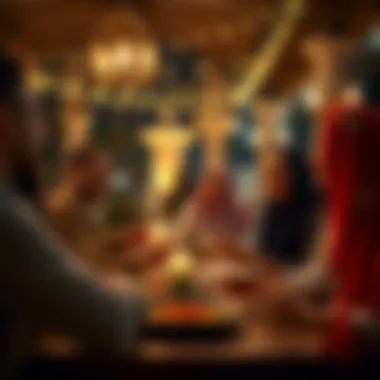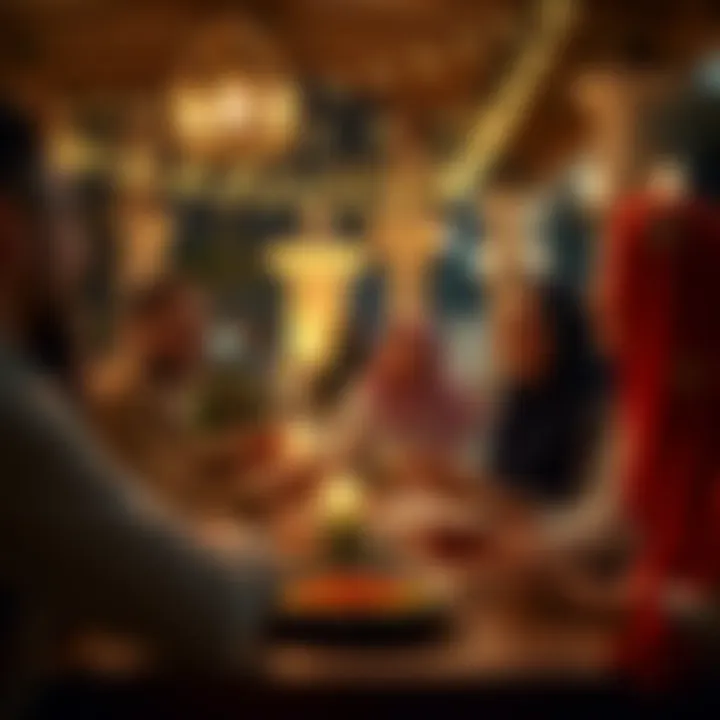Iftar Timing 2023: A Detailed Exploration


Intro
The month of Ramadan is a time of reflection, devotion, and community gathering for millions of Muslims around the world. One of the central components of this sacred month is the iftar, the meal that breaks the daily fast at sunset. As 2023 unfolds, understanding the specific timings for iftar can enhance the observance of this practice, allowing individuals and communities to come together in a meaningful and enriching manner.
Iftar timings are not just about the clock; they carry cultural and spiritual significance that varies from one region to another. Factors influencing these timings include geographical location, local sunrises, and sunsets, alongside religious considerations. As you dig into this guide, you'll appreciate how diverse traditions shape the iftar experience, reflecting varied cultural nuances.
In this article, we will explore:
- The significance of iftar timings across different cultures.
- How local traditions influence the iftar experience.
- Practical tips to prepare for iftar in alignment with your local timings.
- Insights into community practices that enrich the iftar meal.
- The importance of maintaining these traditions in a modern context.
Whether you’re a lifelong practitioner or new to these customs, this guide serves as a valuable resource for navigating what can be a spiritually fulfilling time. Let's delve into the various aspects of iftar timings in 2023, ensuring that you are fully equipped to embrace this important occasion.
Understanding Iftar
In the heart of Ramadan, Iftar stands not just as a meal but as a cornerstone of the faith and culture within Muslim communities. This daily practice of breaking fast at sunset marks the end of a day's fasting and embodies a multitude of significances which extend beyond simply satisfying hunger. By understanding Iftar, we gain insights into its rich layers of tradition, community engagement, and spiritual reflection.
Every evening, as the sun dips below the horizon, millions worldwide partake in this ritual. It's not only a practice of sustenance but also one of unity, where families gather and communities come together. Recognizing these facets of Iftar allows us to appreciate its role in strengthening bonds, both within families and larger communities.
Definition and Importance
Iftar literally translates to "breakfast" in Arabic, derived from the verb 'faṭar,' meaning to break a fast. During Ramadan, Muslims refrain from eating and drinking from dawn until sunset, with Iftar being the event where they can finally enjoy their meals once again. This ceremonial act goes beyond food; it's a deep-seated tradition reflecting values like gratitude and devotion.
The importance of Iftar lies in its ability to remind individuals of the hunger experienced by those less fortunate. Partaking in this meal calls to attention the virtue of charity, reinforcing a sense of social responsibility among those who partake. Plus, these reflections build on the very essence of Ramadan, encouraging self-discipline and spiritual growth. According to reports from community organizations, Iftar gatherings often lead to increased charitable activities, with many choosing to sponsor meals for families in need.
"Iftar transcends the act of eating; it’s a reminder of our blessings and responsibilities to one another."
Historical Context
Historically, Iftar has roots that diverge from contemporary practices. The tradition finds itself back in the days of the Prophet Muhammad, who emphasized the importance of unity in breaking fast with others. From modest helpings in early Islamic communities to the lavish banquets often witnessed today, the evolution of Iftar reflects societal changes over centuries. Archival records suggest that communal experiences of shared meals played an essential role, turning individual observances into collective celebrations.
Moreover, Muslim civilizations throughout history adopted diverse culinary customs into Iftar traditions. For instance, you might find dates and water as the initial items consumed at Iftar, a practice said to emulate that of the Prophet. In many regions, local flavors and ingredients further mark the diversity present in Iftar dishes today, making every region's observance unique.
Cultural Significance
Culturally, Iftar transcends the mere act of eating. It's a tapestry that weaves together traditions, social interactions, and shared values across different communities, varying significantly from one location to another. In countries like Indonesia, elaborate communal dining is the norm, where large gatherings at mosques or public spaces make Iftar events spirited and engaging. Conversely, in Western countries, Iftar often morphs into intimate family dinners, with less communal aspect but rich in family traditions.
In some cultures, there may be an emphasis on preparing specific dishes that symbolize abundance and hospitality, showcasing the local culinary artistry. These meals also serve as a medium for storytelling, where elders share tales from generations past, connecting the youth with their heritage.
Ultimately, Iftar serves as more than just a punctual meal. It is a ritual steeped in love, unity, and reflection. Understanding Iftar paves the way for a more meaningful experience during Ramadan, inviting everyone to grasp the broader implications this tradition carries.
Iftar Timing: An Overview for
Iftar timing holds substantial weight in the observance of Ramadan, as it marks the end of the daily fast. For millions around the globe, this moment is not only about breaking a fast, but it embodies a time of spiritual reflection, community connection, and personal rejuvenation. Understanding Iftar timings for 2023 is vital, as it helps individuals align their daily rhythms with this sacred practice.
Calculation of Iftar Times
The calculation of Iftar times hinges on the location of the observer due to the variation in sunset timings across different regions. Generally, Iftar occurs at sunset, which can be influenced by factors such as position relative to the equator and elevation. In practical terms, Muslims depend on local mosques, Islamic organizations, or Islamic apps that provide precise timings based on calculations or local sightings.
It's worth noting that many communities also use the adhan—the call to prayer—as a cue for Iftar. This means that, irrespective of where someone is in the world, there's a sense of unity witnessed when the call rings out, signaling that it's time to break their fast. A few tools and methods utililzed in determining these times include:
- Solar Position Calculations: Mathematical algorithms can predict sunset times based on latitude and longitude parameters.
- Islamic Authority Announcements: Many Islamic authorities will announce a standardized time that may differ slightly from astronomical data to accommodate local customs.
- Apps and Websites: Tech-savvy users may rely on mobile applications or websites that utilize geolocation services to provide real-time updates for Iftar timings. These tools often simplify the process, ensuring that no one has to guess when to reach for that first date or glass of water.
Variations by Region
The significance of Iftar timings can also vary significantly by region, reflecting local culture and traditions. Different countries, cities, and even neighborhoods may observe subtle variations due to geographical and cultural nuances. Here are a few considerations:
- Geographical Considerations: Countries situated further north may experience longer daylight hours during Ramadan, affecting the timing of Iftar. For example, in some parts of Scandinavia, the sun may not set until late hours, leading to unique adaptations.
- Cultural Observances: Local culture often dictates dining practices post-Iftar. In some areas, the Iftar meal might extend beyond just family to include large community gatherings, whereas in others, it might be a more intimate affair.
- Time Zone Differences: Those who traverse multiple time zones may find themselves adjusting their Iftar schedule accordingly. Expatriates in particular may have to synchronize their practices with their home country or local norm, adding an extra layer of complexity to their observance.
This adds an intriguing layer to the overall dynamics of Ramadan and the Iftar experience, underscoring the importance of cultural and local context.


For additional information, you can find resources on Iftar timings at Wikipedia and Britannica.
Factors Influencing Iftar Timings
The timing of iftar is not a mere coincidence; it is influenced by an array of factors that need careful consideration. Understanding these elements can make a substantial difference in how individuals and communities approach this vital part of Ramadan. Well-timed iftars not only fulfill spiritual obligations but also enhance the overall experience of breaking the fast.
Geographical Location
Geographical location plays an essential role in determining iftar timings. The Earth’s rotation means that different places experience sunset at different times, thus affecting when fasting is concluded from one area to another. For instance, if you find yourself in the bustling markets of Cairo, when the sun kisses the horizon a little past 6:30 PM, you can hear the echoing sounds of prayer and joyous gatherings celebrating the end of the day's fast.
- In some regions, such as northern areas close to the Arctic Circle, the sun might barely set during the summer months, leading those in those places to sometimes have very unique practices; some may choose to follow timings from a nearby city.
- On the flip side, those in equatorial regions experience less variation in sunset times throughout the year, making the calculation of iftar relatively straightforward.
Understanding these nuances can greatly aid expatriates and travelers aiming to observe fasting correctly, ensuring that they align with local traditions. Knowing your environment becomes crucial, especially if you're someone who travels or moves around during Ramadan.
Solar Position and Time Zones
Solar position is another fundamental factor that affects iftar timings. The angle of the sun in relation to the earth determines when it appears to rise and set, directly tying into the observance of iftar. As Ramadan progresses, the position of the sun changes slightly, affecting iftar times day by day. This can lead to variations even within the same city as the month unfolds.
- Many modern devices, including smartphone applications, can provide accurate sunset timings based on solar position. Such resources can be invaluable for those who are immersed in busy urban lifestyles and seek precise information at their fingertips.
- Time zones further complicate the equation. Countries span multiple time zones, which means that iftar could be happening in a city like Riyadh close to an hour earlier than in Dubai, even if they are neighboring countries. Keeping this in mind can help in planning online meetings or if you’re interacting across borders.
"Properly observing iftar is essential not only for spiritual fulfillment but also for fostering a sense of community and togetherness, often best captured when individuals break their fast at the same time."
Iftar Timing Across Different Cities
When it comes to Iftar, the way it is observed can often depend on where you are in the world. The timing of this important meal can be influenced by local culture, traditions, and practices, making it a fascinating topic to explore.
Iftar in Dubai
Local Practices
In Dubai, the Iftar experience is marked by a blend of modernity and tradition. Families usually gather at sunset to break their fast, sharing a meal that reflects both local cuisine and cosmopolitan influences. One standout characteristic is the extensive use of traditional dishes such as dates and hummus, paired with dishes like Mandi or Shawarma. This local flavor enhances the meal's significance and brings a taste of home to many expatriates. Given Dubai’s diverse population, it’s common to find a variety of cuisines available at Iftar gatherings, catering to an array of tastes from across the globe, making it a unique culinary hotpot for this evening ritual.
"Iftar isn't just about breaking the fast; it's about breaking bread with your community. Every dish tells a story."
Community Involvement
Dubai shines in its sense of community during Ramadan. Many local residents volunteer their time or resources to join in communal Iftar events, held at mosques or public parks. These gatherings are not just about food; they serve as a gathering spot for friends and neighbors to share in a spirit of generosity and shared purpose. Emphasis on community gathering helps foster relationships that extend beyond the holy month, cultivating a sense of belonging. The unique feature here is the open buffet style of these events, making it possible for everyone to partake, regardless of background or financial means.
Dining Options
In terms of dining options, Dubai offers an impressive variety for Iftar. From high-end hotels serving luxurious Iftar buffets to local street vendors offering authentic snacks, there’s something for every palate and pocket. This wide range is a beneficial aspect of experiencing Iftar in the city; it allows individuals to choose how they want to observe the occasion, either through lavish gatherings or simple family meals at home. The advantage of having multiple choices is that it not only promotes inclusivity but also allows individuals to indulge in their personal tastes, which enriches the overall experience.
Iftar in Abu Dhabi
Cultural Events
In Abu Dhabi, cultural events play a vital role in enhancing the Iftar experience. Various initiatives celebrate local customs and showcase traditional performances that highlight Emirati heritage. Events often include storytelling, traditional music, or even poetry recitals. These activities not only entertain but also educate attendees about the cultural significance of Ramadan, making it a meaningful way to observe the holy month. A unique aspect of such events is the emphasis on community heritage, allowing both locals and expatriates to connect with UAE’s rich traditions.
Public Gatherings
Public gatherings for Iftar in Abu Dhabi are no ordinary affairs. Large groups of people come together in parks or community spaces, where meals are provided free of cost, emphasizing the value of giving during Ramadan. The key characteristic of these gatherings is their communal nature that fosters a sense of unity among diverse populations. This environment allows people from different backgrounds to engage in conversations, share experiences, and reflect on the essence of the month. However, the challenge sometimes is the logistics involved in organizing such large-scale meals, which can vary year by year, potentially impacting participation rates.
Timing Adjustments
In Abu Dhabi, timing for Iftar may shift slightly each day, aligned with the sunset. Observers commonly refer to local calendars or apps to keep updated, ensuring they break their fast at the right moment. A unique feature of this timing adjustment is how it connects people to the rhythm of nature. This gives a spiritual element to the act of breaking fast, enhancing the reflective mood of Ramadan. Keeping in mind the fluctuations in timing is essential, as it can influence how families plan their Iftar meals day-to-day.
Iftar in Other Key Cities
Saudi Arabia
In Saudi Arabia, Iftar traditions are particularly rich in religious significance. Local customs often entail gathering for prayer before breaking fast, emphasizing the collective experience of worship. A prime characteristic is that Iftar often consists of dishes like Kabsa and Sambusas, which have cultural relevance. The advantage here lies in the unifying aspect of these traditions; they strengthen the bonds among family and friends throughout the month, enhancing the overall Ramadan experience.


Egypt
Egyptian Iftar typically unfolds in a lively manner, with families preparing large feasts that can include Koshari and Om Ali. A defining feature is the vibrant atmosphere, often filled with music and laughter. Such an atmosphere contributes to the enjoyment of Iftar, making it a joyful celebration rather than just a meal. However, the flip side can be the overwhelming nature of food preparation, especially in larger families, leading to stress rather than serenity during this sacred time.
Jordan
In Jordan, Iftar is deeply rooted in Nabatean traditions and is often a time for family reunions. Dishes like * mansaf* are particularly popular, showcasing Jordanian hospitality. The key characteristic of this tradition is its focus on sharing; it’s not uncommon for neighbors to invite one another over for Iftar. The downside may come from varying family dynamics; not all families may be able to gather, which can lead to feelings of isolation among some individuals, somewhat undermining the communal spirit of Ramadan.
Traditional Foods for Iftar
When the sun dips below the horizon, marking the end of the fast for the day, the iftar meal becomes not just about nourishment but also about community, tradition, and reflection. The foods served during iftar hold a special significance, combining flavors, customs, and sometimes even historical recipes passed down through generations. In this section, we will delve into the essential dishes and beverages that make up this sacred meal, as well as examine how they have evolved over time.
Staple Dishes and Beverages
Staple foods for iftar vary significantly across regions, yet there are common threads that bind them together. Dates are universally prized; traditionally, they are the first item consumed to break the fast. This is backed by Hadith that speaks to the Prophet Muhammad's preference for starting his meal with dates. These small, nutrient-rich fruits offer a quick burst of energy and are filled with essential vitamins and minerals.
After the dates, it often becomes a tradition to savor a warm soup, commonly lentil or chicken. This serves as a gentle reintroduction to eating after a long day of fasting. Other staple dishes include:
- Samosas: Fried or baked pastries stuffed with meat or vegetables, often enjoyed for their crispy exterior and flavorful filling.
- Fattoush or Tabouleh: These salads bring freshness to the table, balancing heavier dishes with vibrant herbs and crunchy vegetables, reflecting the seasonality of ingredients.
- Grilled Kebabs or Roasted Meats: Arrival at these dishes signifies a communal celebration, often prepared on open flames, filling the air with tantalizing aromas.
The diversity of beverages during iftar adds another layer to the meal. Tamr Hindi, a sweet date drink, is often lovingly prepared in various households. Likewise, Qamar al-Din, a drink made from apricot paste, provides a sweet yet refreshing taste, encapsulating the flavors of the season. Traditional waters, infused sometimes with mint or lemon, serve as a perfect complement to the meal, helping to replenish lost fluids after the day's fast.
"Food is a universal language; during iftar, it serves as a profound means of connection among family and community."
Variations and Trends
In the modern age, traditions evolve. While many families continue to maintain time-honored recipes, there's a rising inclination toward experimenting with contemporary cuisine during iftar. Each culture contributes unique twists, showcasing local produce and flavors. For instance, you might find elements of Mediterranean cuisine intermingling with Middle Eastern dishes in places with diverse populations.
The trend of fusion meals has taken root, leading to creatively crafted iftar platters that include:
- Sushi with Arabic flavors: Incorporating ingredients like smoked lamb and spices.
- Macaron with Date Filling: Marries French dessert techniques with traditional Middle Eastern sweets.
- Health-conscious dishes: As more individuals focus on diet and fitness, options like quinoa salad with a twist of zesty citrus have surfaced, catering to the health-conscious.
Moreover, the rise of social media has transformed the iftar dining experience. People enthusiastically share their iftar spreads, leading to new trends in food presentation and innovative culinary creations. Home cooks and professional chefs alike are finding inspiration in digital spaces, thus elevating traditional roles and recipes to contemporary standards.
Health Considerations During Iftar
Observing Iftar during Ramadan brings not only spiritual enrichment but also requires attention to physical health. Tuning into health considerations during iftar can make a remarkable difference in how one feels both during Ramadan and beyond. The careful management of nutrition and hydration is vital, as this special meal breaks a day's fast, impacting energy levels, mood, and overall well-being.
Nutrition and Hydration
When the sun dips below the horizon, the anticipation of breaking the fast fills the air, yet it’s crucial to approach iftar with a plan. The primary objective should be to incorporate a balanced diet that nourishes the body after a long day of abstaining from food and drink.
- Fruits and Vegetables: These should lead the table. Fresh dates, often consumed first, provide quick energy due to their high glucose content. Moreover, watermelon, cucumber, and salads not only hydrate but also refresh the palate.
- Complex Carbohydrates: Rice, whole grains, and legumes offer sustained energy release. This helps avoid quick spikes and drops in blood sugar levels, ensuring that energy remains steady.
- Proteins: Integrating lean meats, fish, or legumes fulfills the body’s need for protein. Grilled chicken or lentil dishes cater well to this requirement without being too heavy on the stomach.
Hydration
Dehydration can be a genuine concern during Ramadan, particularly if iftar is approached mindlessly.
- Water: Begin the meal with a glass of water. It's a good way to ease your tummy into accepting food after hours of fasting. Experts suggest sipping rather than gulping, to better allow the body to adjust.
- Avoid Sugary Drinks: They may be tempting, but they can lead to more thirst later. Instead, opting for fresh juices or herbal teas can be refreshing without the accompanying sugar overload.
In essence, spending a few minutes to properly plan the meal can yield benefits that reach far beyond the sustenance of the evening.
Cautions for Health Conditions
For some individuals, iftar can pose health challenges, especially for those managing chronic conditions or specific health issues. It's essential to not only revel in the communal aspect of breaking the fast but also to practice prudence.
- Diabetes: For those with diabetes, it’s imperative to monitor their blood sugar closely. Skipping meals or eating high-carb, sugary foods can lead to dangerous spikes in glucose levels. Planning portions and maintaining regular blood sugar checks can help mitigate risks.
- Hypertension: Salty foods might seem tempting, but they can escalate blood pressure. Excessive intake can lead to feelings of fatigue and lethargy, which can overshadow the joy of iftar. So, it may be wise to limit salty snacks and opt for more natural flavors.
It’s not just what you eat during iftar, but how you eat that matters too. Moderation and mindfulness are key.


- Heart Conditions: Those with heart conditions should be mindful of their overall salt intake and seek to include heart-healthy fats from olive oil or nuts, rather than fried foods.
Taking into account these health considerations can turn iftar into a nourishing and wholesome experience, enabling individuals to savor every moment of fasting and feasting throughout Ramadan.
Community Gatherings and Iftar
During the holy month of Ramadan, community gatherings play a crucial role in the observance of iftar. These events bring together individuals and families, fostering a sense of unity and shared purpose. The communal aspect of breaking fast strengthens bonds, allowing for an engaging experience that transcends mere sustenance. It is not just about the food; it’s about the collective spirit and goodwill that permeates the atmosphere.
Mosque Iftar Events
Iftar gatherings in mosques are particularly significant. These events often host sizable groups, where people from diverse backgrounds come to share their meal. The mosque becomes a hub of connectivity, drawing in not only the local community but also expatriates and newcomers, forging friendships and alliances.
- Food is typically provided, ranging from traditional dishes to contemporary options, making the event inclusive.
- Prayers and reflections enhance the experience, reminding attendees of the spiritual significance of Ramadan.
- Such events often serve as a platform for community outreach, allowing local organizations to share information about various services.
These mosque events symbolize generosity, with individuals sometimes donating meals for those who are less fortunate. The collective experience of breaking fast amidst shared prayers creates a profound sense of belonging and comfort for many.
Charity Initiatives
Charity during Ramadan does not just stop at donations; it thrives within the iftar setting. Numerous charity initiatives spring up during this time, aiming to cater to those in need.
- Food Drives: Many organizations organize food drives that culminate in iftar gatherings focused on providing meals for the less fortunate.
- Sponsoring Iftar: Wealthier members of the community often sponsor iftar meals, ensuring that no one goes hungry. This act not only addresses food insecurity but also reinforces a culture of giving.
- Community Fundraising Events: These initiatives take place alongside iftar, encouraging collective fundraising efforts for various social causes.
"During Ramadan, every act of kindness counts, and the communal spirit shines brightest when we come together to support one another."
In essence, communal gatherings and charity initiatives during iftar highlight the season’s emphasis on empathy and solidarity. These gatherings nurture connections, allowing individuals to engage in acts of kindness while simultaneously adhering to their cultural and spiritual responsibilities.
Preparing for Iftar
The preparation for iftar is not merely a routine; it encapsulates the spirit of Ramadan within its folds. Each day as the sun dips below the horizon, thousands of families, friends, and communities come together to break their fast, turning a simple meal into a rich tapestry of culture, tradition, and togetherness. This section delves into how one can thoughtfully embrace the essence of iftar, ensuring that every meal shared reflects not only nourishment but also gratitude and social connection.
Planning a Menu
When it comes to planning an iftar menu, it’s crucial to consider both the nutritional balance and the cultural significance of the dishes. The heart of any iftar lies in its food, and diverse traditions inspire many recipes, often depending on geographic locations.
To create a menu that resonates with your family and guests, consider the following:
- Starter Dishes: Dates and water often kick off the meal, aligning with the traditions observed by Prophet Muhammad. Additionally, the inclusion of light soups or salads can prepare the palate for the main course.
- Main Dishes: Depending on your origins or preferences, you might choose slow-cooked stews like Moroccan tagines or hearty biryanis, each rich in spices and flavor.
- Sweets: End the meal on a sweet note, with options like baklava or kunafa that honor Middle Eastern culinary heritage. They not only taste great but also provide an energy boost.
- Beverages: Don’t forget refreshing drinks, such as mint lemonade or rose syrup-infused water, which help nicely round off the meal.
This plan can accommodate dietary restrictions, ensuring everyone at the table feels included. When crafting the menu, be mindful of measuring portions so as not to waste food, which is an important consideration especially during Ramadan.
Shopping Tips
When it comes time to hit the grocery store, a little strategy goes a long way. Planning your shopping is as vital as planning your menu. Here are some practical tips to streamline your iftar grocery shopping experience:
- Make a List: Write down all the ingredients needed for your menu. This saves time wandering aimlessly through aisles.
- Shop Early or Late: Try to go shopping during off-peak hours to avoid the hustle and bustle of last-minute shoppers. This will make for a more pleasant experience while you browse.
- Local Markets: Consider sourcing fresh produce from local farmers’ markets, which may have seasonal items that can enhance your menu while supporting local economies.
- Bulk Buying: If you anticipate hosting multiple iftars, consider buying staple items in bulk. This can save money and time in the long run.
- Check Expiry Dates: Always check expiry dates on perishables to ensure you’ll have fresh ingredients for the duration of Ramadan.
Remember, preparing for iftar is also a form of worship, as it demonstrates your appreciation of the meal you’re about to enjoy. Incorporating local ingredients not only pays homage to your community but also makes it a more meaningful gathering.
"In the end, it’s the memories created over meals that linger far longer than the food itself."
By following these insights into preparing for iftar, you set the stage for not just a meal, but an occasion filled with abundance, warmth, and deep-rooted connections.
End
In summarizing the core aspects of this article, it becomes evident that the examination of iftar practices in 2023 is not merely a reflection of dining customs during Ramadan, but a gateway into understanding the rich tapestry of culture, community, and personal reflection. Recognizing the synchronized rhythm of iftar timings across various regions plays a vital role, not just in everyday life but in fostering a sense of unity among Muslims globally. This period of breaking fast serves as a moment of personal and communal reconnection—one that transcends geographic boundaries.
Reflecting on Iftar Practices
When delving into iftar practices, we embark on a journey that emphasizes the importance of tradition while acknowledging the influences of modernity. Each region brings its own flavor to the iftar table, blending age-old recipes with contemporary culinary trends. People are seen gathering around tables laden with a delightful array of dishes, from dates and water to hearty stews and desserts. The act of breaking fast often comes with a sense of gratitude and spirituality, where participants reflect on the day's trials and triumphs.
Moreover, iftar is not just about food; it holds a mirror to societal values, such as hospitality and generosity. Hosting an iftar is seen as a noble endeavor. Families, friends, and even strangers come together, fostering bonds and creating an atmosphere of fellowship. This is especially important in a world that sometimes feels fragmented—these moments inspire compassion and understanding among diverse communities.
Moving Forward in Community Spirit
As we advance in life, the spirit of iftar can guide us toward deeper community engagement. Embracing the values inherited from our rich traditions encourages us to forge connections that ripple outward. Community initiatives, such as charity iftars or shared meals, create bridges among people of different backgrounds and beliefs. As individuals become more aware of the collective impact they can have, there's greater potential for promoting social responsibility and mutual support.
In fostering this communal spirit, we cultivate an environment where everyone feels involved and valued. The essence of Ramadan, particularly through practices like iftar, challenges us to move beyond individual concerns and engage with the wider world. So, as we reflect on these practices, let them inform our actions not just during the holy month but throughout the year. This mindset can turn moments of personal reflection into a platform for ongoing communal growth, leading to a more cohesive society.



